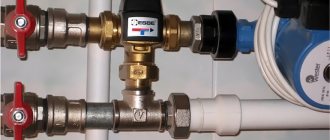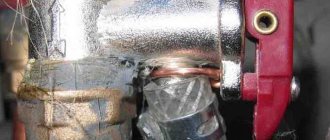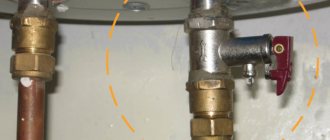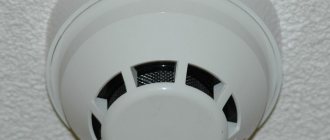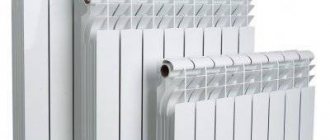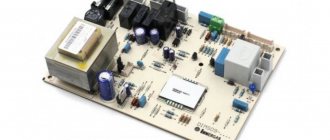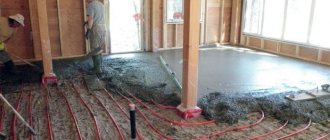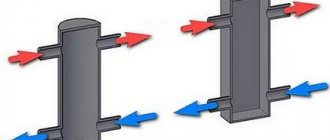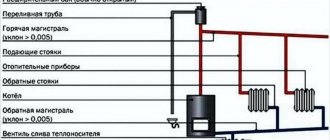In heating systems, where heaters and coolers are used in the piping units, a characteristic type of fittings is found - a two-way valve. The device quickly and accurately regulates the volume of water supply and withdrawal. It is in demand in heating, ventilation and air conditioning systems. Nowadays, two-way valves equipped with an electric drive and controlled by special sensors are in great demand. These are reliable and easy-to-install devices, the design features and differences of which we will learn below.
Two way valve
Purpose and design
The classic configuration of the device is as follows:
- thermostatic valve;
- thermal head with remote sensor;
- thermal head valve;
- limit sensor that takes into account temperature;
- meter;
- circulation pump;
- water filter;
- check valve
Two-way adjusters are used everywhere, but a lot depends on what material they are made of. Considering the design features, we will immediately make a reservation that valves come with one or two seats. Using the second type, the flow of the working medium is regulated and blocked, and significant pressure drops are allowed, which a valve with a single seat cannot cope with. The valve itself looks like a separate part with a mechanical or electronic drive. It happens that an additional energy source is not provided, so it is installed after installation of the device.
Advantages of a two-way valve:
- simple design;
- easy to install;
- does not require human involvement to work effectively;
- repairable;
- reliable;
- lasts a long time;
- hermetically sealed;
- characterized by low hydraulic resistance;
- available.
Paying attention to the design of the element, it will seem that it is similar to a standard valve, but the mechanisms differ significantly. For example, the main closing element of a valve is a stem or ball. That is, a rod located in a horizontal or vertical position, or a ball rotated around its axis by 90 degrees, is responsible for limiting the flow of water. The device operates according to a simple scheme - a special hole opens and liquid is transported through it. In order for these structural elements to function, an actuator is connected to the valve, which requires electricity or compressed air. The drive itself is combined with separate instruments that take into account pressure in the system, temperature and other characteristics.
Valve design
Three-way valve: operating principle
In general, the operating principle of this plumbing device can be described in a few sentences. The return and supply pipelines connect to the two inlets of the tee. The required temperature regime is adjusted using regulatory mechanisms.
During the first pass, the coolant flows as expected. On the way back it is already cooled, which immediately affects the overall temperature of the coolant. Within a few seconds, the sensor reacts to temperature changes and increases the hot water content in the system. He will open the valve until the water in the heating system reaches an acceptable temperature.
The main advantage that a three-way valve has is its operating principle: this device is autonomous and unpretentious, as it works independently. All that is required is configuration and testing of its functionality during the installation process.
Areas of use
As noted above, this type of control valve is used in heating, ventilation and air conditioning systems. We will separately consider the features of its use in a circuit with a “warm floor”.
If a boiler is installed in the house, then its task is to heat water and, as a rule, its temperature is quite high, suitable for radiators (from +75 to +95 degrees Celsius). For a “warm floor” system, such heating is not needed, since sanitary standards regulate a maximum of +35 degrees Celsius. This indicator is enough to comfortably walk on the floor covering. If the temperature is higher, this will not only cause inconvenience to residents, but will also negatively affect the finishing floor covering. For example, linoleum or laminate are easily deformed.
The “warm floor” is installed under the screed; in addition, different flooring materials are used. To do this, the coolant is heated to +50 degrees Celsius. When a heated floor is directly connected to a boiler or centralized heating system, the resulting temperature is too high. To reduce it at the entrance to the circuit, install a mixing valve for a warm floor, with a two-way or three-way tap already provided. Based on the name, the purpose of such fittings is to mix hot and cold water circulating along the circuit. That is, the process of fluid passage changes - for the radiator, the water remains hot, but the already mixed water, which has a lower temperature, is supplied to the warm floor.
Installed valve
What materials is it made from?
Cast iron, brass and steel products are now common. For example, fittings made of cast iron and steel are installed in pipeline systems with large flows of water or steam. Brass valves are often found in ventilation systems. Their main advantage is their compact size, so the element can be installed even in small rooms with limited water consumption.
It is recommended to use a steel or cast iron control valve. Steel products are common, which are just as strong as their cast iron counterparts, but are much cheaper. When choosing a material, the pressure characteristics in the system and the dimensions of the fittings themselves are taken into account.
Steel valve
Conclusion
If you need to adjust the water flow in your heating or cooling system, a two-way valve can help. It is made from various materials
, including steel and brass, while in the first version it is the most resistant to pressure and temperature, in the other it is the least resistant. (See also the publication Filter for the heating system: specifics.) The device can only be installed with a mesh filter that traps dirt accumulated in the water supply, heating or ventilation system. The video in this publication will provide an opportunity to find additional information on the above topic.
Types of control valves
Reinforcement differs in several ways.
Depending on the design features, there are 2 types:
- walk-through - in them the pipes have the opposite arrangement;
- angular - located at an angle of 90 degrees.
Pay attention to how the valve is controlled.
According to this parameter, there are 3 types:
- pneumatic;
- hydraulic;
- equipped with electric drive.
The electrical drive device is a low-power electric motor or retractor solenoids. Of course, there are products with manual control, but they are more difficult to operate, since they do not allow you to set precise parameters. The devices operate from an electrical network with alternating current 220 V or direct current 24 V.
Certain pass-through units operate in autonomous mode, without power supply. Such fittings are controlled and regulated by means of a membrane and a counteracting spring. As feedback, a circuit is used along which the coolant moves - it also directs the membrane in the desired direction.
What does a two-way valve provide:
- consumption is regulated, resources (water) are distributed and saved;
- more economical heat consumption;
- equipment and networks are protected from pressure surges;
- If used correctly, the valve extends the life of the connected equipment and the network itself.
The devices are mounted using flanges, threads or welding. One of the subtypes of a threaded connection is a pin-type fastening, in which the valve is screwed into another device. When the installation is welded, special pipes are used.
We will separately highlight the valve with remote control, which is the easiest to operate. Such devices are complemented by electric drives or remote controls. It is the control rooms that accept all the current characteristics and parameters of the system. The pressure decreases remotely, the pressure increases, or certain branches of the heating network are blocked.
A type of two-way valve
Connection diagram
For water heated floors, the valve is most often installed in a parallel circuit. To implement it, 2 or 3 heating circuits with circulating coolant must be used. The water supply and pressure is regulated by one or more valves installed in parallel. When mixing the coolant in parallel, you should disconnect the heated floor lines in advance.
As a rule, control taps are adjusted independently, manually, where the required volume of water flow is set.
Important! If a parallel circuit is used, it is recommended to replace the bypass with a bypass valve. This is done in order to reduce the operating load and save electricity supplied to the pump.
The circuit has a minus - the coolant entering the circuit will be the same temperature as the water leaving the return circuit to the boiler. Because of this, hot water is distributed unevenly along the circuits.
Installation diagram for heated floors
Installation Features
The procedure itself boils down to connecting the valve to the necessary pipelines. In order for the fittings to work for a long time and without problems, the connection should be implemented correctly, taking into account all the tips and recommendations. If you lack experience, it is recommended to contact specialists. Otherwise, the heating system will not be as efficient and economical as it should be.
Before starting installation work, pay attention to the two-way valve - its body has an external or internal thread onto which the union nut (or fitting) of the pipeline is screwed. For a reliable connection, experts advise wrapping the thread with a sealant, which can be used as FUM tape.
The fittings are supplied with special gaskets that ensure the proper level of tightness. If these are not available, then you will have to purchase them separately, of the appropriate thickness and diameter. The main task is to ensure a tight connection, without distortions on the threads, which will prevent possible leaks. No special tools or devices are required.
Note! Two-way valves do not operate under the simplest conditions, namely under the influence of high temperatures. Because of this, threaded connections may lose their tightness, so the connection procedure must be carried out responsibly.
Expert advice:
- During installation, ensure that there is no force in the piping.
- Before installing the element on the water supply system, the latter should be thoroughly cleaned, removing all impurities. They negatively affect the condition of the sealing materials, which leads to the valve’s tightness being compromised.
- Over time, the device may need to be repaired or dismantled, so it is necessary to leave enough free space around it.
- It is important to carry out careful installation. If a flange connection is used, it is recommended to tighten the corresponding screws alternately to avoid internal stress. With the threaded installation method, adjustment links are used, which will allow the valve to be dismantled in the future.
- If you need to blow out or flush the entire pipeline system, the valve is removed and an adapter is installed in its place.
Installation is a complex process and largely depends on the chosen scheme. To avoid mistakes, we recommend ordering valve installation services from specialists.
Valve in the heating system
What is the difference between a three-way valve and a two-way valve?
Unlike a two-way valve, the operation of a three-way valve has a completely different principle. In this case, the rod does not block the constant flow of the hydraulic mode. It is constantly open and tuned to a certain volume. As a result, consumers receive a certain volume in quantitative and qualitative equivalent. In other words, the valve is not capable of blocking movement on the regular hydraulic flow circuit. At the same time, it can block the variable direction, which allows you to control flow and pressure.
A three-way valve on a heating system was obtained by combining a pair of two-way devices. Only both must work sequentially - when one closes, the second begins its work.
